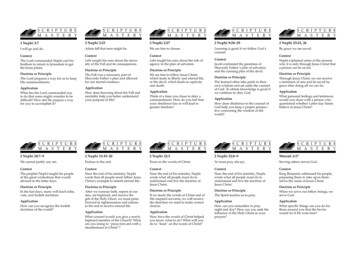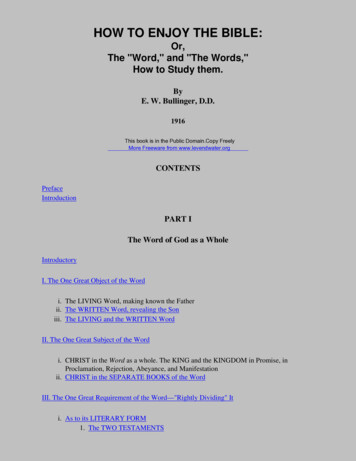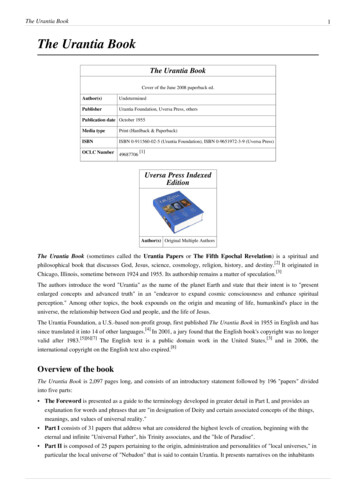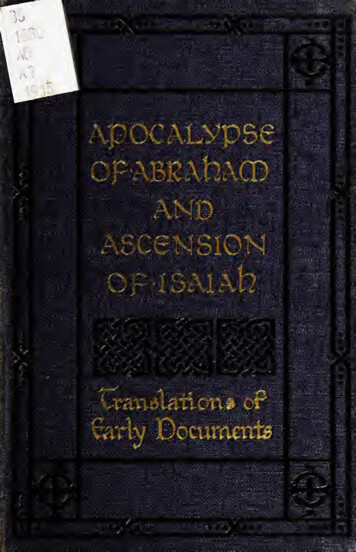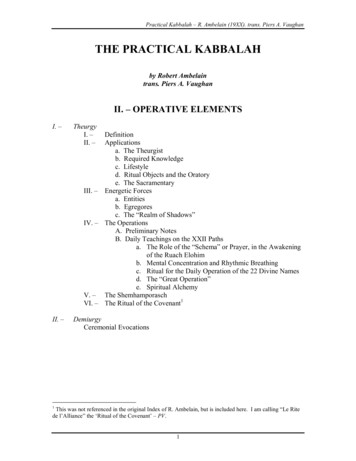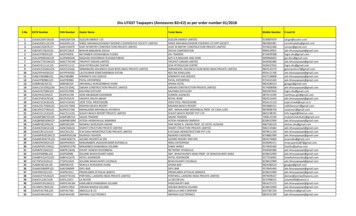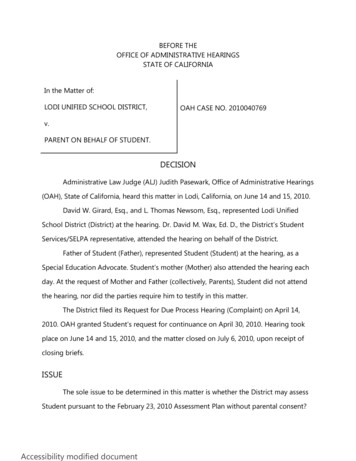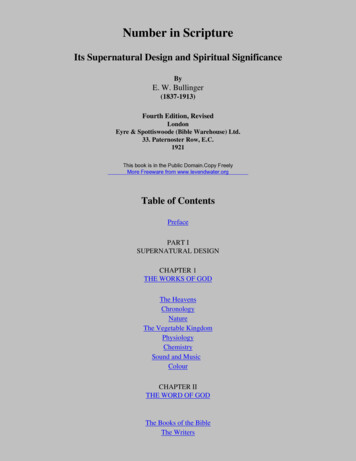
Transcription
Number in ScriptureIts Supernatural Design and Spiritual SignificanceByE. W. Bullinger(1837-1913)Fourth Edition, RevisedLondonEyre & Spottiswoode (Bible Warehouse) Ltd.33. Paternoster Row, E.C.1921This book is in the Public Domain.Copy FreelyMore Freeware from www.levendwater.orgTable of ContentsPrefacePART ISUPERNATURAL DESIGNCHAPTER 1THE WORKS OF GODThe HeavensChronologyNatureThe Vegetable KingdomPhysiologyChemistrySound and MusicColourCHAPTER IITHE WORD OF GODThe Books of the BibleThe Writers
Occurrences of Words in OldTestamentOccurrences of Words inNew TestamentOccurrences of Words in theApocalypseOccurrences of PhrasesEvidence as to Authorship ofHebrews and 2 PeterOccurrences of Words andPhrases in Old and NewTestaments combinedPART IISPIRITUAL nSix and Seven togetherSeven by itselfEightEight and Seven togetherEight by itselfEight and Thirteen four
SeventyOne hundred and twentyOne hundred and fifty andthreeTwo hundredThree hundred and ninetyFour hundredFour hundred and thirtyFour hundred and ninetySix hundred and sixty-sixConclusion
PrefaceMany writers, from the earliest times, have called attention to the importance of the great subjectof Number in Scripture. It has been dealt with, for the most part, in a fragmentary way. One hasdealt with some particular number, such as "seven"; another has been content with a view of theprimary numbers, and even when defining their significance, has given only one or twoexamples by way of illustration; another has confined himself to "symbolical numbers," such as10, 40, 666, etc.; another has taken up such symbolical numbers in their relation to chronologyor to prophecy; another has collected examples, but has dealt little with their meaning.There seemed, therefore, to be room, and indeed a call, for a work which would be morecomplete, embrace a larger area, and at the same time be free from the many fancies which all,more or less, indulge in when the mind is occupied too much with one subject. Anyone whovalues the importance of a particular principle will be tempted to see it where it does not exist,and if it be not there will force it in, in spite sometimes of the original text. Especially is this thecase when chronology is dealt with, the greater uncertainty of dates lending itself more readilyto the author's fancy.The greatest work on this subject, both chronological and numerical, is not free from thesedefects. But its value is nevertheless very great. It is by the late Dr. Milo Mahan, of New York.His work Palmoni*, which was republished among his collected works, has long been out ofprint. It greatly increased my interest in this subject, and led me to further study, besidesfurnishing a number of valuable illustrations.* Not the anonymous Palmoni by an English author, published in London.It is too much to hope that the present work should be free from these defects, which areinseparable from human infirmity. From one point of view it is a subject which must provedisappointing, at any rate to the author, for illustrations are continually being discovered; andyet, from another point of view, it would be blasphemy to suppose that such a work could becomplete; for it would assume that the wonders of this mine could be exhausted, and that itstreasures could be all explored!I must, therefore, be content with the setting forth of general principles, and with giving a fewexamples from God's Word which illustrate them, leaving others to extend the application ofthese principles and search out illustrations of them for themselves.May the result of this contribution to a great subject be to stimulate the labours of Biblestudents; to strengthen believers in their most holy faith; and to convince doubters of the Divineperfection and inspiration of the Book of Books, to the praise and glory of God.E.W. BULLINGER17 North End Road,Golders Green, N.W.
Back Contents NextPART IITS SUPERNATURAL DESIGNChapter IDESIGN SHOWN IN THE WORKS OF GOD"Who hath measured the waters in thehollow of His hand;And meted out heaven with a span;And comprehended the dust of theearth in a measure,And weighed the mountains in scales,And the hills in a balance?" (Isa40:12)"The works of the LORD are great,Sought out of all them that havepleasure therein." (Psa 111:2)There can be neither works nor words without number. We can understand how man can act and speakwithout design or significance, but we cannot imagine that the great and infinite Creator and Redeemercould either work or speak without both His words and His works being absolutely perfect in everyparticular."As for God His WAY is perfect" (Psa 18:30). "The Law of the LORD is perfect" (Psa 19:7). They areboth perfect in power, perfect in holiness and righteousness, perfect in design, perfect in execution,perfect in their object and end, and, may we not say, perfect in number."The LORD is righteous in all His ways: and holy in all His works" (Psa 145:17).All His works were (and are) done, and all His words were spoken and written, in the right way, at theright time, in the right order, and in the right number. "He telleth the number of the stars" (Psa 147:4).He "bringeth out their host by number" (Isa 40:26). "He weigheth the waters by measure" (Job 28:25).We may, therefore, say with David: "I meditate on all Thy works; I muse on the work of Thy hands" (Psa143:5).In all the works of God we find not only what we call "Law," and a Law-maker, but we observe a Lawenforcer. We speak of laws, but they are nothing in themselves. They have no being; they possess nopower; they cannot make themselves, or carry themselves out. What we mean when we speak of law innature is simply this: God in action; God not merely giving or making laws, but carrying them out andenforcing them.
As He is perfect, so His works and His words also must be perfect. And when we see number used not bychance, but by design; not at haphazard, but with significance; then we see not merely so many worksand words, but the Living God working and speaking.In this first part of our subject we are to speak only of design in the use of number; and in the secondpart, of significance. In this first chapter we will confine our thoughts to design as it is seen in the worksof God; and in the second, as it is seen in the Word of God.When we see the same design in each; the same laws at work; the same mysterious principles beingcarried out in each, the conviction is overwhelming that we have the same great Designer, the sameAuthor; and we see the same Hand, the same seal stamped on all His works, and the same signature orautograph, as it were, upon every page of His Word. And that, not an autograph which may be torn off orobliterated, but indelible, like the water-mark in the paper; so impressed upon and interwoven with itthat no power on earth can blot it out.Let us turn first toTHE HEAVENSHere we see number displayed in a remarkable manner. The 12 signs of the Zodiac, each with threeconstellations, making 36 in all, which together with the 12 signs make a total of 48. There must be areason, therefore, why the number 12 should thus pervade the heavens. Why should 12 be thepredominating factor? Why should it not be 11, or 13, or 7, or 20?Because 12 is one of the four perfect numbers, the number of governmental perfection; hence it isassociated with the rule of the heavens, for the sun is given "to rule the day," and the moon "to governthe night." The significance of this, however, must be deferred till we come to consider the number"twelve" under this head. It is enough for us now to notice the fact here, upon the threshold of oursubject, that we have one common measure, or factor, which is seen in the 12 signs of the Zodiac, the 36(3x12) constellations,* the total 48 (4x12); the 360 (12x30) degrees, into which the great circle of theheavens is divided. No one can tell us why the number of degrees was first fixed at 360. It has come downto us from ancient times, and is used universally without a question.** And it is this division of theZodiac which gives us the 12 months of the Zodiacal year. This is called also the Prophetic year, for it isthe year which is used in the prophecies of the Bible.**** There are other modern constellations now: Hevelius (1611-1687) added twenty-two; Halley(1656-1742) added fifteen. But every one knows how different these are from the ancientconstellations, both in their names, their character, and their utter absence of all significance.** It probably arises from the product of the four numbers, 3, 4, 5, 6, which arise out of thephenomena which lie at the root of Geometrical and Arithmetical Science. 3 x 4 x 5 x 6 360,while 360 x 7 2520.*** There are different or relative kinds of years, according as we reckon the revolutions of thesun in relation to certain objects, e.g.: (1.) In relation to the equinoctial points. The time takenby the sun to return to the same equinoctial point is called the Solar year (also the Civil, orTropical year), and consists of 365.2422414 solar days (or 365 days 5 hours 48 minutes 49.7seconds). (2.) In relation to the stars. The time taken by the sun to return to the same fixed staris called the Sidereal year, and consists of 365.2563612 solar days (or 365 days 6 hours 9minutes 9.6 seconds). (3.) In relation to his own orbit. The time taken by the sun to return to thesame point in his own orbit is called the Anomalistic year, and consists of 365.2595981 solardays (or 365 days 6 hours 13 minutes 49.3 seconds). The word "Anomalistic" means irregular,
and this kind of year is so called because from it the first irregularities of planetary motionwere discovered.Here, then, is an example of number as it is used in the heavens. Twelve is the pervading factor.CHRONOLOGYIt is not necessary to go into the intricacies of this vast part of our subject. Notwithstanding the fact thatGod gave to man these heavenly time-keepers, he has so misused the gift (as he has every other giftwhich God has ever given him) that he cannot tell you now what year it really is! No subject is in morehopeless confusion, made worse by those who desire the dates to fit in with their theories of numbers,instead of with the facts of history.We shall, therefore, avoid man's use of numbers. Our only concern in this work is with God's use of them.Here we shall find both design and significance. Here, therefore, we shall find that which is certain andfull of interest.The first natural division of time is stamped by the Number seven. On the seventh day God rested fromHis work of Creation.When He ordained the ritual for Israel which should show forth His work of Redemption, seven is againstamped upon it in all its times and seasons. The seventh day was the holy day; the seventh month wasspecially hallowed by its number of sacred festivals; the seventh year was the Sabbatic year of rest forthe land: while 7 x 7 years marked the year of Jubilee (Lev 25:4,8).Thirty jubilees bring us from the Exodus to the opening of Christ's ministry, when, opening Isaiah 61:2,He proclaimed "the acceptable year of the Lord" in a seven-fold prophecy (see Luke 4:18-21).The great symbolical divisions of Israel's history, or rather of the times of God's dealings with them, aremarked by the same number; and if we confine ourselves to duration of years rather than to thesuccession of years and chronological dates; with καιρος (kairos), season, a definitely limited portion oftime, rather than with χρονος (chronos), time, the course of time in general* (hence our word"chronology"), —we shall have no difficulty.* In modern Greek καιρος has come to mean weather, and χρονος, year, thus preserving theessential distinction between the two words.God's dealings with His people have to do with actual duration of time rather than with specific dates;and we find that His dealings with Israel were measured out into four periods, each consisting of 490 (70times 7) years. Thus:—The 1st. From Abraham to the Exodus.The 2nd. The Exodus to the Dedication of Temple.The 3rd. From the Temple to Nehemiah's return.The 4th. From Nehemiah to the Second Advent.It is clear that these are periods of duration having regard only to Israel, and to Jehovah's immediatedealings with them. For in each one there is a period of time during which He was not immediatelygoverning them, but in which His hand was removed, and His people were without visible tokens of Hispresence with them.
1. From the birth of Abraham to the ExodusYears TotalFrom the birth of Abraham to the Exodus was actually (Gen 12:4,16:3 and 21:5)*505But deducting the 15 years while Ishmael was Abram's seed,delaying the seed of promise- 15Leaving the first 70 x 7 of years490*Abraham was 75 years old when the promise (Gen 12:4) was made to him. The Law was given430 years after (Exo 12:40; Gal 3:17). But 430 and 75 make 505 years, or 15 years over the490. How are we to account for this gap of 15 years as forming part of the 505 years? Theanswer is that at Abraham's departure into Canaan (12:4) he was 75 years old, Ishmael wasborn 10 years after (16:3), therefore Abraham was 85 years old at Ishmael's birth. But he was100 years old when Isaac was born (21:5). Therefore it follows that there were 15 years (100minus 85 15) during which Ishmael was occupying and usurping the place of the "promisedseed"; and 15 from 505 leaves 490. Here then we have the first of the seventy-seven of years,and the first "gap" of 15 years.2. From the Exodus to the foundation of the Temple, accordingYears Totalto Acts 13:20:*In the Wilderness40Under the Judges450Saul40David40Solomon (1 Kings 6:1,37)3But from these we must deduct the Captivities under573Cushan (Judges 3:8)8Eglon (Judges 3:14)18Jabin (Judges 4:3)20Midianites (Judges 6:1)7Phil
E. W. Bullinger (1837-1913) Fourth Edition, Revised London Eyre & Spottiswoode (Bible Warehouse) Ltd. 33. Paternoster Row, E.C. 1921 This book is in the Public Domain.Copy Freely More Freeware from www.levendwater.org Table of Contents Preface PART I SUPERNATURAL DESIGN CHAPTER 1 THE WORKS OF GOD The Heavens Chronology Nature The Vegetable Kingdom Physiology Chemistry
